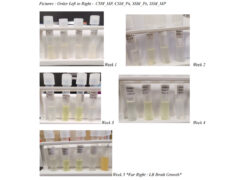In conclusion, most of the soil samples collected contained some kind of bacteria that was capable of degrading organophosphates. This shows potential for future advancements to clean the soil of the pesticide pollutants. Prior to the experiment, I hypothesized that there would be very little bacteria that would be able to break down the pesticides Px and MP in either the CSM or SSM solutions. However, after comparing the results from the class as a whole, I was proven wrong. Personally, I thought this was impressive. It is hard to comprehend that there is bacteria in most of the soil samples that could degrade and metabolize the pesticides.
For my sample, Student 6, I had two tubes, SSM_Px and CSM_Px, show bright enough yellow to move on to inoculation in the LB Broth. However, only the CSM_Px sample grew. This is shown in the figure for week 5, the far right tube. The next few weeks would be spent plating, and it was fascinating to see the growth.
I am beyond thankful for the opportunity to participate in the research project, and I am excited to see the project continue to grow. An important takeaway is to be more aware of the various forms of pollutants, and their everlasting effect on the soil and other environmental factors. I look forward to advancements in using bacteria to rid the soil of the pesticide contaminants, or organophosphates, using bioremediation.


